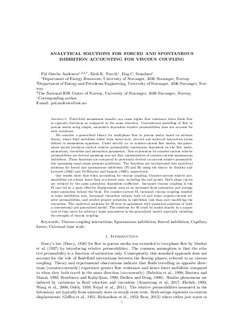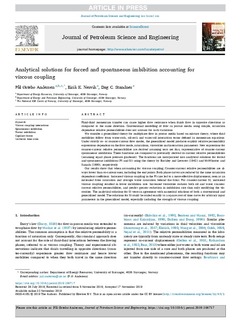| dc.contributor.author | Andersen, Pål Østebø | |
| dc.contributor.author | Kjos Nesvik, Eirik | |
| dc.contributor.author | Standnes, Dag Chun | |
| dc.date.accessioned | 2020-01-08T09:40:03Z | |
| dc.date.available | 2020-01-08T09:40:03Z | |
| dc.date.created | 2019-11-17T19:30:31Z | |
| dc.date.issued | 2019-11-22 | |
| dc.identifier.citation | Andersen, P.Ø., Nesvik, E.K., Standnes, D.C. (2019) Analytical solutions for forced and spontaneous imbibition accounting for viscous coupling. Journal of Petroleum Science and Engineering | nb_NO |
| dc.identifier.issn | 0920-4105 | |
| dc.identifier.uri | http://hdl.handle.net/11250/2635257 | |
| dc.description.abstract | Fluid-fluid momentum transfer can cause higher flow resistance when fluids flow in opposite directions as compared to the same direction. Conventional modelling of flow in porous media using simple, saturation dependent relative permeabilities does not account for such variations. We consider a generalized theory for multiphase flow in porous media based on mixture theory, where fluid mobilities follow from water-rock, oil-rock and water-oil interaction terms defined in momentum equations. Under strictly co- or counter-current flow modes, the generalized model produces explicit relative permeability expressions dependent on the flow mode, saturations, viscosities and interaction parameters. New expressions for counter-current relative permeabilities are derived assuming zero net flux, representative of counter-current spontaneous imbibition. These functions are compared to previously derived co-current relative permeabilities (assuming equal phase pressure gradients). The functions are incorporated into analytical solutions for forced and spontaneous imbibition (FI and SI) using the theory by Buckley and Leverett (1942) and McWhorter and Sunada (1990), respectively. Our results show that when accounting for viscous coupling; Counter-current relative permeabilities are always lower than co-current ones, including the end points. Both phase curves are reduced by the same saturation dependent coefficient. Increased viscous coupling in the FI case led to a more effective displacement, seen as an increased front saturation and average water saturation behind the front. For counter-current SI, increased viscous coupling resulted in lower imbibition rate. Increased viscosities reduces both oil and water counter-current relative permeabilities, and predict greater reduction in imbibition rate than only modifying the viscosities. The analytical solutions for SI were in agreement with numerical solutions of both a conventional and generalized model. The solutions for SI could be scaled exactly to a square root of time curve for arbitrary input parameters in the generalized model, especially including the strength of viscous coupling. | nb_NO |
| dc.language.iso | eng | nb_NO |
| dc.publisher | Elsevier Ltd. | nb_NO |
| dc.rights | Attribution-NonCommercial-NoDerivatives 4.0 Internasjonal | * |
| dc.rights.uri | http://creativecommons.org/licenses/by-nc-nd/4.0/deed.no | * |
| dc.subject | petroleumsteknologi | nb_NO |
| dc.subject | viscous coupling interactions | nb_NO |
| dc.title | Analytical solutions for forced and spontaneous imbibition accounting for viscous coupling | nb_NO |
| dc.type | Journal article | nb_NO |
| dc.type | Peer reviewed | nb_NO |
| dc.description.version | publishedVersion | nb_NO |
| dc.rights.holder | © 2019 The Authors. | nb_NO |
| dc.subject.nsi | VDP::Technology: 500::Rock and petroleum disciplines: 510::Petroleum engineering: 512 | nb_NO |
| dc.source.journal | Journal of Petroleum Science and Engineering | nb_NO |
| dc.identifier.doi | 10.1016/j.petrol.2019.106717 | |
| dc.identifier.cristin | 1748444 | |
| dc.relation.project | Norges forskningsråd: 230303 | nb_NO |
| cristin.unitcode | 217,8,11,0 | |
| cristin.unitname | Institutt for energiressurser | |
| cristin.ispublished | false | |
| cristin.fulltext | postprint | |
| cristin.qualitycode | 2 | |


